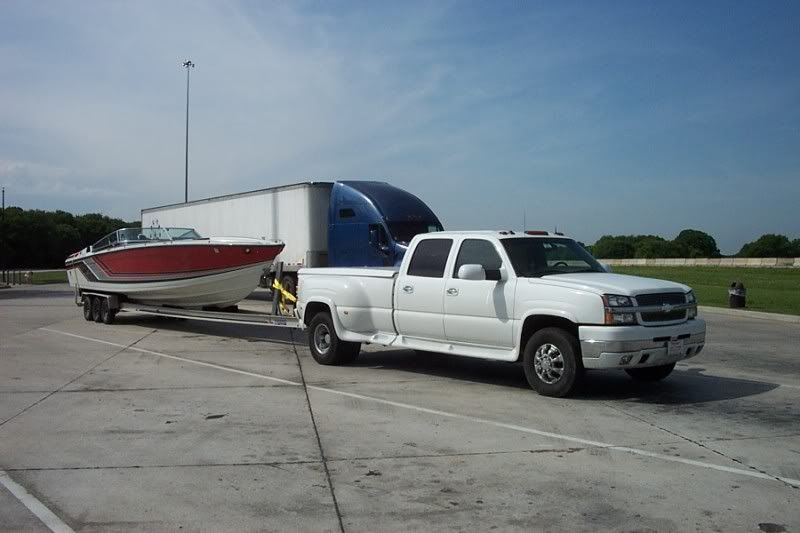Wired2Cruze
Member
- Jun 11, 2010
- 122
- Boat Info
- 1996 Sundancer 250, Garmin 431S GPS, towed by 2006 Dodge durango
- Engines
- 5.7L Merc w/BravoIII
Hey everyone,
Just got back from our inaugural Lake Erie trip over Memorial Day Weekend, and got to experience the 'wild' side of boating- blowing 2 trailer tires tires on the same trip!
I figure my total weight is somewhere around 8700 lbs (boat,trailer, gas, water, equipment & 2 of us), and I use a WD hitch on my Eagle tandem axle.
I was doing about 55-60 mph on a hot (90F) afternoon, when about 45 min into a 2.5 hour trip the first one blew.
Got it replaced w/the spare, which was about a 45-min exercise, then resumed, but at 45-50 mph. We stopped in Bucyrus (about the 1/2 way point) for dinner and a chance to let the tires cool.
About 10 miles from home we lost the 2nd one ( I could see the smoke as it blew!). Drove 1 mile at 3mph to a well-lighted parking lot, and dropped the boat & trailer.
Got a Goodyear Marathon this morning (ST225/75R15D), which was the same size/rating as the Carlisles I had on the trailer. I should add that the Carlisles were supposedly 3 years old w/500 miles on them, according to the former owner.
I put maybe another 500 on them last year.
I figured I may as well replace the remaining tires, so I got 3 more Goodyears.
The tire guy inflated the tires to 40 psi.
When I asked him what the optimal range was, he said anywhere 40-50, because the tires have a max psi rating of 60.
He said that given the conditions I experienced last nite (hot weather, tire age), tires can expand a max of 10 psi over their cold pressure, so he was cautious.
I should also note that the sticker on my trailer noting the optimal inflation pressure was too faded to read.
So now my question (sorry for the lengthy intro):
What is the optimal tire pressure for my rig, given the weight & tire ratings?
I feel 40 is a little low, but ok for just around here, we boat maybe 10 miles from our home. I'm leaning toward 45-50, thinking they would wear better.
Maybe I should keep them 50 for around home, then deflate to 45 for summer road trips?
What do you guys suggest?
Anybody have experience with under/over inflation?
Just got back from our inaugural Lake Erie trip over Memorial Day Weekend, and got to experience the 'wild' side of boating- blowing 2 trailer tires tires on the same trip!
I figure my total weight is somewhere around 8700 lbs (boat,trailer, gas, water, equipment & 2 of us), and I use a WD hitch on my Eagle tandem axle.
I was doing about 55-60 mph on a hot (90F) afternoon, when about 45 min into a 2.5 hour trip the first one blew.
Got it replaced w/the spare, which was about a 45-min exercise, then resumed, but at 45-50 mph. We stopped in Bucyrus (about the 1/2 way point) for dinner and a chance to let the tires cool.
About 10 miles from home we lost the 2nd one ( I could see the smoke as it blew!). Drove 1 mile at 3mph to a well-lighted parking lot, and dropped the boat & trailer.
Got a Goodyear Marathon this morning (ST225/75R15D), which was the same size/rating as the Carlisles I had on the trailer. I should add that the Carlisles were supposedly 3 years old w/500 miles on them, according to the former owner.
I put maybe another 500 on them last year.
I figured I may as well replace the remaining tires, so I got 3 more Goodyears.
The tire guy inflated the tires to 40 psi.
When I asked him what the optimal range was, he said anywhere 40-50, because the tires have a max psi rating of 60.
He said that given the conditions I experienced last nite (hot weather, tire age), tires can expand a max of 10 psi over their cold pressure, so he was cautious.
I should also note that the sticker on my trailer noting the optimal inflation pressure was too faded to read.
So now my question (sorry for the lengthy intro):
What is the optimal tire pressure for my rig, given the weight & tire ratings?
I feel 40 is a little low, but ok for just around here, we boat maybe 10 miles from our home. I'm leaning toward 45-50, thinking they would wear better.
Maybe I should keep them 50 for around home, then deflate to 45 for summer road trips?
What do you guys suggest?
Anybody have experience with under/over inflation?




